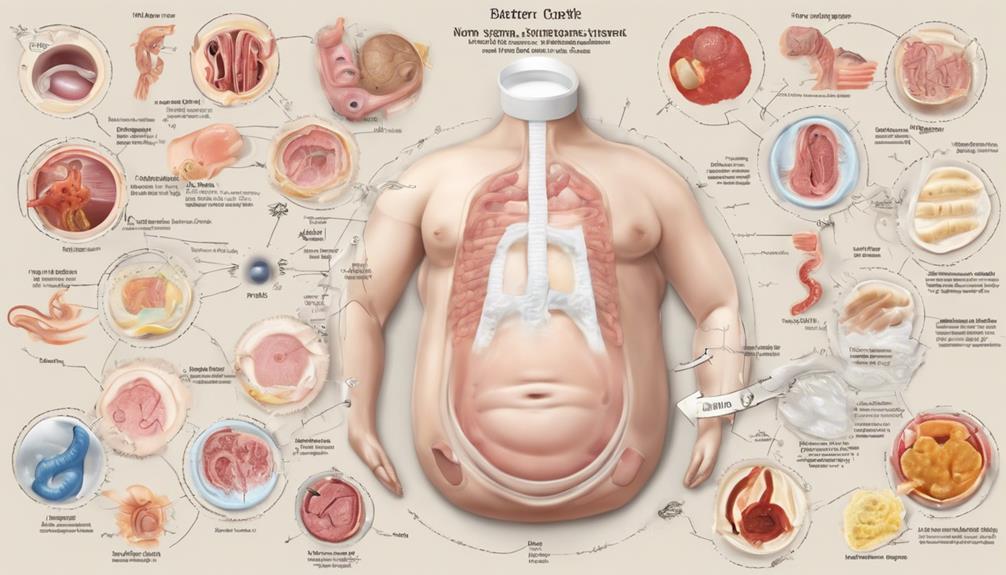In the United States, there is a popular saying: “Where there’s smoke, there’s fire.” It can be concerning to experience spotting during the second trimester of a pregnancy, but learning about the possible causes can provide clarity and help alleviate anxieties.
Exploring the reasons behind this common occurrence can shed light on potential issues that may arise as the pregnancy progresses.
Let's uncover the mysteries behind these 5 common triggers of spotting and gain insight into what expectant mothers should be aware of during this critical phase of pregnancy.
Key Takeaways
- Implantation bleeding is common and may cause spotting in the second trimester.
- Cervical changes, such as increased vascularity, can lead to spotting during pregnancy.
- Infections like STIs or UTIs can result in bleeding and require prompt treatment.
- Sexual intercourse may cause spotting due to increased blood flow, usually resolving without issues.
Implantation Bleeding
Implantation bleeding typically occurs 6-12 days after conception and may appear as light pink to dark brown in color. This light spotting is a normal part of early pregnancy and is usually not cause for concern. It differs from the heavier bleeding experienced during menstruation and typically lasts from a few hours to up to 3 days.
During implantation, as the fertilized egg attaches to the uterine lining, some light bleeding may occur. This can be alarming for some individuals, but it's important to remember that it's a natural process. If the bleeding is minimal, stays within the light pink to dark brown spectrum, and isn't accompanied by severe pain, it's likely just a sign of the embryo implanting itself in the uterus.
Cervical Changes

Cervical changes during the second trimester of pregnancy can often lead to spotting due to increased vascularity and hormonal shifts affecting the cervix. The cervix becomes more vascular and friable during pregnancy, making it more prone to bleeding. Hormonal fluctuations can further contribute to this sensitivity, resulting in spotting. Conditions like cervical ectropion, where glandular cells extend to the outer surface, and cervical polyps, benign growths on the cervix, can also lead to bleeding and spotting in the second trimester. Additionally, regular cervical exams, while important for monitoring pregnancy, may trigger minor bleeding due to the increased sensitivity of the cervix. These changes are typically benign but can cause concern for expectant mothers. Understanding the reasons behind spotting during the second trimester can help alleviate anxiety and guarantee appropriate medical attention if needed.
| Cervical Changes | Effect on Pregnancy | Management |
|---|---|---|
| Increased vascularity and friability | May lead to spotting | Monitor closely |
| Cervical ectropion | Glandular cells extend out, causing bleeding | Often resolves on its own |
| Cervical polyps | Benign growths can bleed and cause spotting | Evaluation by healthcare provider |
Infections
During the second trimester of pregnancy, concerns about spotting may also arise due to the potential impact of infections like sexually transmitted infections (STIs) or urinary tract infections (UTIs). Infections can lead to light bleeding and are often accompanied by symptoms such as a burning sensation during urination, abnormal discharge, and pelvic pain.
It's essential to promptly address these infections to prevent complications for both the pregnant individual and the fetus. UTIs, for example, can be diagnosed through urine tests and are typically treated with antibiotics that are safe for pregnancy. Healthcare providers may recommend specific treatment plans based on the type and severity of the infection causing spotting in the second trimester.
If you experience any unusual symptoms like spotting along with signs of infection, such as burning during urination or pelvic discomfort, it's important to seek medical attention promptly for appropriate evaluation and management.
Sexual Intercourse
Engaging in sexual activity can sometimes result in spotting during the second trimester of pregnancy due to increased blood flow to the cervix and hormonal changes. The cervix may become more sensitive during pregnancy, which can lead to light bleeding after intercourse.
It's important to remember that spotting after sex is usually essential; however, consulting a healthcare provider is significant to rule out any underlying concerns. To reduce the risk of spotting after intercourse, using lubrication and opting for gentle intercourse positions can be beneficial.
If spotting persists, becomes severe, or is accompanied by pain, seeking medical advice for proper evaluation and guidance is essential. Remember, your healthcare provider is there to support you through any concerns you may have during this intimate time.
Placenta Previa
Placenta previa, a condition where the placenta partially or completely covers the cervix, can lead to painless vaginal bleeding in the second or third trimester of pregnancy. This unexpected bleeding can be alarming for expectant mothers, but understanding the risk factors is essential. Factors such as previous C-sections, multiple pregnancies, or advanced maternal age increase the likelihood of developing placenta previa.
Diagnosis of placenta previa is typically achieved through ultrasound, allowing healthcare providers to assess the placental position accurately. If diagnosed with this condition, treatment options may include bed rest and close monitoring of both the mother's and baby's well-being. In severe cases, a C-section delivery might be necessary to avoid complications like hemorrhage during labor.
It's essential for pregnant individuals experiencing painless vaginal bleeding in the second or third trimester to seek immediate medical attention. By addressing placenta previa promptly and following medical advice, the risks associated with this condition can be minimized, ensuring the best possible outcome for both the mother and the baby.
Frequently Asked Questions
Is It Normal to Have Light Spotting in the Second Trimester of Pregnancy?
Yes, light spotting in the second trimester can be normal. It's often caused by minor factors like cervical irritation or growths. However, any unusual or heavy bleeding should be discussed with a healthcare provider promptly for evaluation and guidance.
Why Am I Bleeding During My Second Pregnancy?
We're here to help! Bleeding during the second trimester of pregnancy can be caused by various factors. It's crucial to seek medical advice promptly to guarantee the health of both you and your baby.
When Should I Start Worry About Spotting During Pregnancy?
If you experience spotting during pregnancy, it is crucial to monitor closely. Contact your healthcare provider when spotting is severe or accompanied by unusual symptoms. Early evaluation guarantees your peace of mind and the well-being of you and your baby.
Is Bleeding at 5 Months Pregnant Normal?
Bleeding at 5 months pregnant is concerning and should prompt immediate medical evaluation. It's not considered normal and could indicate serious issues. Seeking medical advice is vital for a proper diagnosis and management plan.
Conclusion
To sum up, spotting during the second trimester of pregnancy can be caused by various factors such as implantation bleeding, cervical changes, infections, sexual intercourse, and placenta previa.
It's important to seek medical advice if you experience any bleeding, as it could indicate a more serious issue. Remember, better safe than sorry – always trust your instincts and reach out to your healthcare provider for guidance.
Stay informed, stay proactive, and take care of yourself and your baby!










